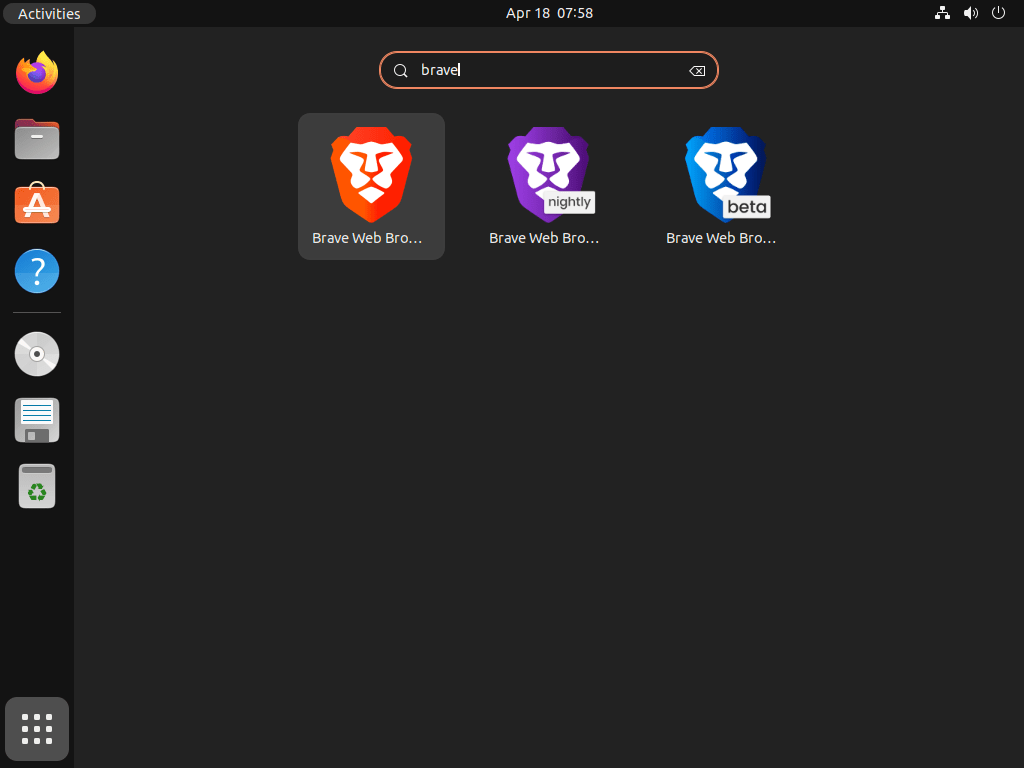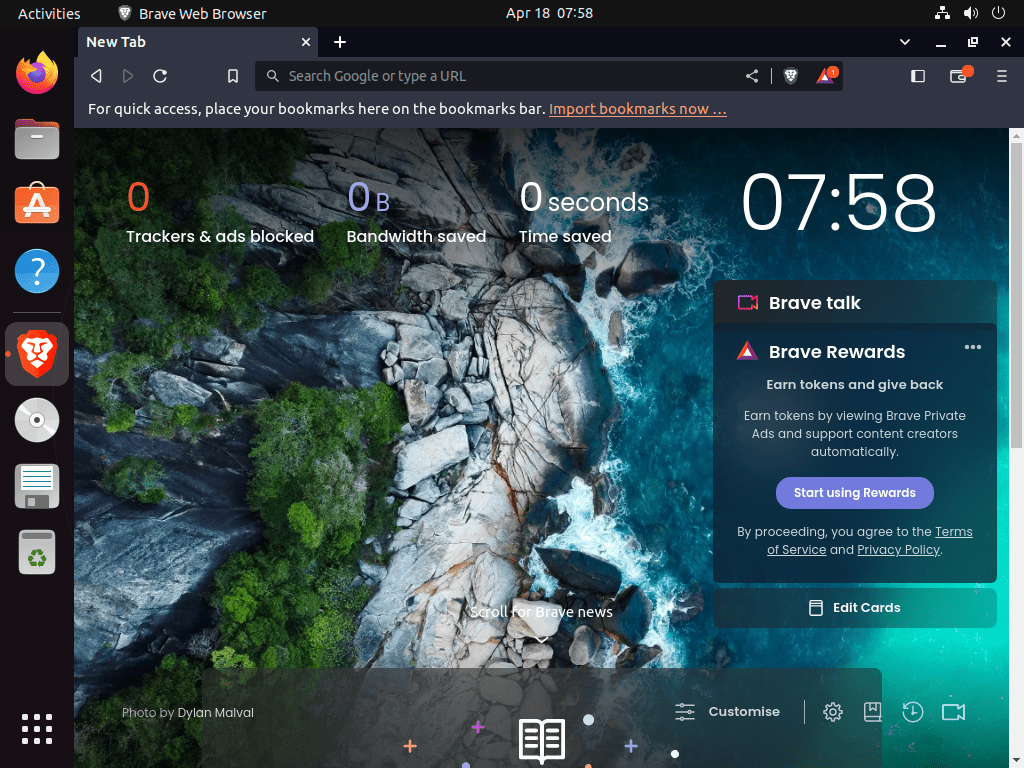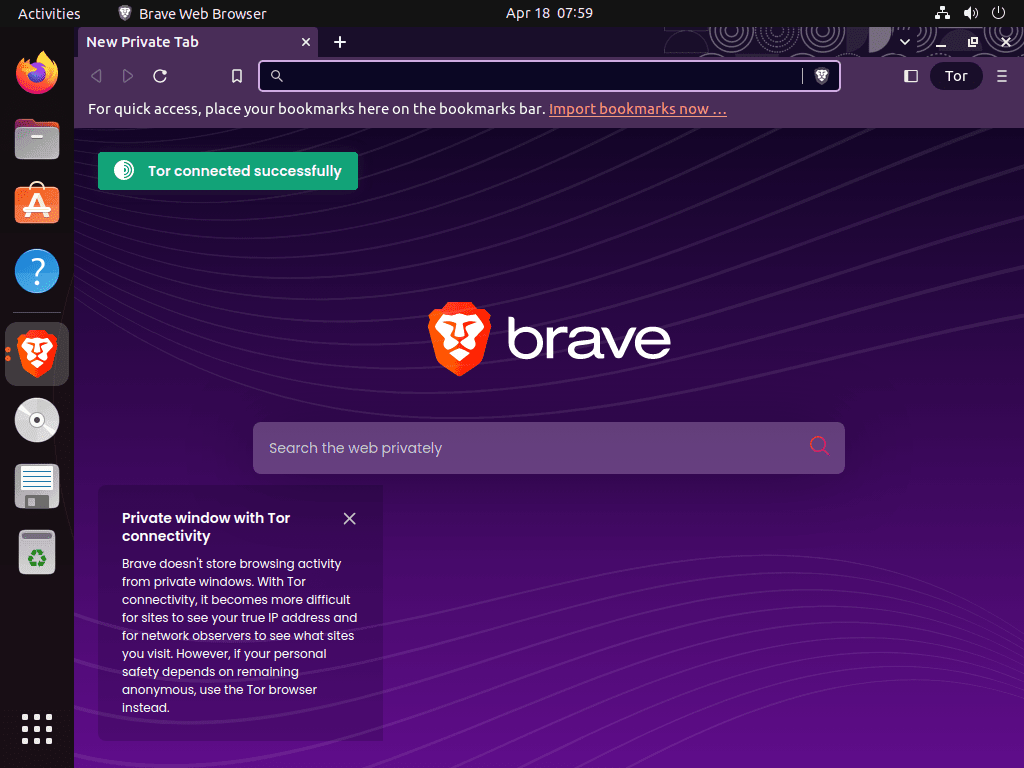Brave Browser offers a Chromium-based alternative focused on privacy and performance. Unlike Chrome or Firefox, Brave blocks ads and trackers by default without extensions, supports most Chrome extensions for compatibility, and includes optional features like Brave Rewards for cryptocurrency earnings and built-in Tor browsing for enhanced anonymity. The browser delivers faster page loads by eliminating ad processing while maintaining full access to the Chrome Web Store ecosystem.
This guide covers installing Brave Browser on Ubuntu using three methods: APT repository with stable, beta, or nightly builds for traditional package management; Snap for sandboxed installations with automatic updates; and Flatpak for cross-distribution compatibility. You’ll learn complete setup from repository imports and GPG key verification through browser launch, with guidance on choosing the installation method that best fits your update preferences and system configuration.
Choose Your Brave Browser Installation Method
Brave Browser offers three installation paths on Ubuntu, each with different trade-offs for version access, update control, and system integration. The APT repository method provides the widest channel selection (stable, beta, nightly) with traditional Debian package management. Snap and Flatpak deliver sandboxed installations that isolate the browser from system files, but both only offer the stable channel. Choose based on whether you need bleeding-edge features or prefer automatic containerized updates.
| Method | Version/Channel | Stability | Best For |
|---|---|---|---|
| APT Repository | Stable, Beta, Nightly | Stable for stable channel; Beta and Nightly may have bugs | Users wanting full channel access (including beta/nightly builds) with traditional package management and manual update control |
| Snap | Stable only | Stable, auto-updates daily | Users preferring sandboxed applications with automatic background updates and simplified management |
| Flatpak | Stable only | Stable, updates via Flathub | Users wanting cross-distribution compatibility, sandboxing, and control over update timing while maintaining isolation from system packages |
Brave Software officially recommends using the APT repository method over Snap or Flatpak when possible. While Brave maintains both Snap and Flatpak packages, they acknowledge these containerized versions are “not yet working as well” as native packages due to sandboxing limitations that can affect desktop integration, performance, and certain browser features. Choose Snap or Flatpak only if you specifically need cross-distribution portability or enhanced isolation.
Most users should choose the APT stable repository for reliable performance with standard system integration and the best browser experience as recommended by Brave Software. The beta and nightly channels provide early access to upcoming features but may introduce instability or bugs suitable only for testing environments. Snap and Flatpak offer enhanced security through containerization, but the sandbox environment can cause desktop integration issues with file pickers, desktop notifications, system theme inheritance, and other native features. If you need bleeding-edge Brave features, use APT with the beta or nightly repository; for daily browsing, the APT stable method delivers the optimal experience.
Prerequisites for Installing Brave Browser on Ubuntu
Any Ubuntu desktop or laptop with sudo access and an internet connection can install Brave Browser with no extra hardware requirements. Make sure you can open a terminal and run commands with sudo, then keep a stable network connection active while the repositories synchronize.
It also helps to refresh your package lists ahead of time with sudo apt update so new Brave packages appear immediately after you add the repository.
Method 1: Install Brave Browser via APT Repository
Check If Brave Browser Is Already Installed
Verify whether Brave already exists on your system, especially if you tested beta or nightly builds in the past.
command -v brave-browser && brave-browser --versionIf you use the beta or nightly channels, adjust the command to brave-browser-beta or brave-browser-nightly. When a version number prints, you can skip directly to the update instructions later in this section.
Update System Package Index
Before starting the installation process, update your Ubuntu system to minimize potential conflicts and ensure all dependencies are current.
To update your system, execute the following command in your terminal:
sudo apt update && sudo apt upgradeInstall Repository Management Tools
Install the necessary packages for managing third-party repositories and secure key handling. Run the following command in your terminal:
sudo apt install software-properties-common apt-transport-https curl ca-certificates -yIf unsure, run the command; it will not harm you. These are common software packages found on nearly all Linux distributions.
Add Brave Repository and GPG Key
Next, Brave Browser offers three repository options: stable, beta, and nightly builds. The stable version is recommended for most users as it delivers reliable performance. However, advanced users or those curious about upcoming features can install the beta or nightly repositories, which run as separate installations alongside the stable version.
Beta and nightly channels provide early access to new features but may introduce bugs or instability. Use these channels only in testing environments or when you need specific upcoming functionality. The stable channel receives thorough testing and offers the most reliable browsing experience for daily use.
Option 1 – Import Brave Browser Stable (Recommended)
To import the GPG key for the stable version of Brave Browser, execute the following command:
sudo curl -fsSLo /usr/share/keyrings/brave-browser-archive-keyring.gpg https://brave-browser-apt-release.s3.brave.com/brave-browser-archive-keyring.gpgNext, download and add the stable repository configuration by running this command:
sudo curl -fsSLo /etc/apt/sources.list.d/brave-browser-release.sources https://brave-browser-apt-release.s3.brave.com/brave-browser.sourcesOption 2 – Import Brave Browser Beta
To import the GPG key for the beta version of Brave Browser, execute the following command:
sudo curl -fsSLo /usr/share/keyrings/brave-browser-beta-archive-keyring.gpg https://brave-browser-apt-beta.s3.brave.com/brave-browser-beta-archive-keyring.gpgNext, download and add the beta repository configuration by running this command:
sudo curl -fsSLo /etc/apt/sources.list.d/brave-browser-beta.sources https://brave-browser-apt-beta.s3.brave.com/brave-browser.sourcesOption 3 – Import Brave Browser Nightly
To import the GPG key for the nightly version of Brave Browser, execute the following command:
sudo curl -fsSLo /usr/share/keyrings/brave-browser-nightly-archive-keyring.gpg https://brave-browser-apt-nightly.s3.brave.com/brave-browser-nightly-archive-keyring.gpgNext, download and add the nightly repository configuration by running this command:
sudo curl -fsSLo /etc/apt/sources.list.d/brave-browser-nightly.sources https://brave-browser-apt-nightly.s3.brave.com/brave-browser.sourcesUpdate APT Package Lists
After adding the desired Brave repository, update the package list to include the newly added packages. Execute the following command:
sudo apt updateInstall Brave Browser from Repository
Now that the repositories are configured, you can install the Brave Browser stable version or any other channel (beta or nightly). The commands below cover all installation options.
To install the stable version of Brave Browser, execute the following command in your terminal:
sudo apt install brave-browserAfter the installation is complete, you can verify the successful installation and check the build and version by running this command:
brave-browser --versionInstall Brave Browser Beta Build
If you have imported the beta repository and would like to install the beta version of Brave Browser, run the following command:
sudo apt install brave-browser-betaTo verify the installation and check the beta version, execute the following command:
brave-browser-beta --versionInstall Brave Browser Nightly Build
If you have imported the nightly repository and wish to install the nightly version of Brave Browser, use this command:
sudo apt install brave-browser-nightlyAfter installing the nightly version, you can confirm the installation and check the nightly build version by running this command:
brave-browser-nightly --versionThe following two methods, using Snap or Flatpak with Flathub to install Brave Browser, only support the stable version, which most users should use on their Ubuntu system. Use the APT method above if you need beta or nightly builds.
Method 2: Install Brave Browser via Snap
Snap offers a straightforward method for managing and deploying software. This section guides you through installing the Brave Browser through Snap.
Verify Snap Installation
Canonical, the team behind Ubuntu, introduced Snap as a universal package management system. Confirm it exists on your machine before proceeding:
snap versionIf the command prints version information, Snap is ready. When you see a command not found message, install Snap with the following command:
sudo apt install snapd -yThis command sets up the Snap Daemon (snapd) that manages your snap packages.
Install Brave Browser with Snap
Once Snap is confirmed installed, check whether Brave is already present as a Snap package:
snap list braveIf the command reports Brave is not installed, run the install command below. When the list output shows Brave is already present, use the refresh command after the install block to pull the latest build.
sudo snap install braveHere, ‘sudo’ grants you administrative rights, ‘snap’ calls the Snap package manager, ‘install’ instructs you to install a package, and ‘brave’ is the software you aim to install.
If Brave already exists as a Snap package, refresh it with the command below instead of reinstalling it to get the latest build.
sudo snap refresh braveMethod 3: Install Brave Browser via Flatpak and Flathub
This section introduces you to installing the Brave Browser via the Flatpak package manager. Like Snap, Flatpak offers a unique approach to software deployment, ensuring applications can run across almost any Linux distribution through an isolated runtime environment.
Verify Flatpak Installation
Flatpak is preinstalled on some Ubuntu editions, but minimal images may omit it. Confirm whether Flatpak is available with the following command:
flatpak --versionIf the command reports “flatpak: command not found,” follow our guide How to Install Flatpak on Ubuntu to set it up before continuing.
Enable Flathub Repository
To install the Brave Browser using Flatpak, first activate the Flathub repository, a primary source for Flatpak apps. Run the following command to add Flathub to your Flatpak setup:
sudo flatpak remote-add --if-not-exists flathub https://flathub.org/repo/flathub.flatpakrepoThis command integrates the Flathub repository, providing access to various applications including the Brave Browser.
Install Brave Browser with Flatpak
Check whether the Brave Flatpak is already present before installing:
flatpak list --app | grep -i braveIf no output appears, proceed with the install command below. When Brave is already listed, update it with the command below:
sudo flatpak update com.brave.BrowserAfter setting up Flathub, install Brave Browser on your Ubuntu system with the command below:
sudo flatpak install flathub com.brave.Browser -yThis command installs the Brave Browser from Flathub, ensuring you receive the latest stable version.
Launch Brave Browser
After successfully installing Brave Browser, you can launch the browser using either command-line or graphical methods. Choose the approach that suits your workflow.
Launch from Command Line
You can launch Brave Browser directly from the terminal by executing the appropriate command based on the version you have installed:
Stable installations of the Brave browser can use one of the following commands that match the method of installation:
APT installations
brave-browserSnap installations:
snap run braveFlatpak installations:
flatpak run com.brave.BrowserFor Brave beta and nightly APT installations, use the following commands depending on the version you installed and want to run:
brave-browser-betabrave-browser-nightlyLaunch from Application Menu
Alternatively, you can easily find and launch Brave Browser from your desktop environment using the following steps:
- Click on Activities or your system’s application launcher.
- Click on Show Apps or a similar option to display the installed applications.
- Locate the Brave Web Browser icon and click on it to launch the browser.



Additional Commands for Brave Browser
Update Brave Browser
To keep Brave Browser up-to-date, you can use the APT package manager. First, check for available updates for your entire system:
sudo apt updateIf there is an update available for Brave Browser, you can upgrade all packages:
sudo apt upgradeAlternatively, you can update Brave Browser directly without updating all the packages simultaneously. For example, to update the stable version of Brave Browser:
sudo apt upgrade brave-browserAlternatively, Snap installations can run the following terminal command to blanket-check all packages installed for updates:
sudo snap refreshSimilar to Snap update command, the same command methodology can be used for Flatpak:
sudo flatpak updateRemove Brave Browser
Uninstall Brave Browser APT Package
If you need to uninstall Brave Browser, follow these steps based on the installed version(s).
sudo apt remove brave-browsersudo apt remove brave-browser-betasudo apt remove brave-browser-nightlyNext, if you plan not to re-install Brave, you should remove the added repositories and use the following commands based on the version(s) you have installed:
sudo rm /etc/apt/sources.list.d/brave-browser-release.sourcessudo rm /etc/apt/sources.list.d/brave-browser-beta.sourcessudo rm /etc/apt/sources.list.d/brave-browser-nightly.sourcesThese commands will remove the specific Brave Browser repositories. By removing the repositories, you prevent future updates to the browser, and it will no longer appear in your package manager.
Uninstall Brave Browser Snap Package
To remove Brave Browser that was installed via Snap, use the following command:
sudo snap remove braveUninstall Brave Browser Flatpak Package
Similar to Snap, removing Brave Browser from Ubuntu installations is as simple as one command:
sudo flatpak uninstall flathub com.brave.BrowserConclusion
Brave Browser delivers privacy-focused web browsing through Chromium with ad and tracker blocking by default. The installation process covers APT repository setup with stable, beta, and nightly channels, or universal Snap and Flatpak options for sandboxed installations. Your Ubuntu system now runs a privacy-first browser that blocks tracking without extensions, supports Chrome plugins, and offers optional Tor integration for enhanced anonymity.
Useful Links
Here are some valuable links related to using the Brave browser:
- Brave Official Website: Visit the official Brave website for information about the browser, its features, and download options.
- Brave Search: Use Brave’s search engine for privacy-focused browsing.
- Web Discovery Project: Learn about the Web Discovery Project and how it enhances your browsing experience while maintaining privacy.
- Brave FAQ: Find answers to frequently asked questions about using Brave.
- Brave Community: Join the Brave community forum to discuss issues, share solutions, and get support from other users.
- Brave Latest Release Notes: Stay updated with the latest release note updates from Brave.
- Brave Transparency: Explore Brave’s transparency reports and learn about their commitment to privacy and security.
- Brave GitHub Repository: Access the Brave GitHub repository to view the source code, report issues, and contribute to the development.
- Install Chromium on Ubuntu: Guide to installing Chromium, the open-source browser that Brave is built upon.
- Install Tor Browser on Ubuntu: Install Tor Browser for maximum anonymity and privacy-focused browsing.
- Install Vivaldi Browser on Ubuntu: Explore Vivaldi, a feature-rich Chromium-based browser with advanced customization options.
- Install Firefox Beta or Nightly on Ubuntu: Try Firefox’s development channels for early access to upcoming features.



Brave Browsr has “saved” a password I did NOT want saved, …. How do I remove that “saved” password.
Thanks for reaching out, Fred. Removing unwanted saved passwords in Brave is straightforward through the browser’s password manager.
Open Brave and click the three-line menu icon (top-right), then navigate to Settings → Additional Settings → Auto-fill → Password Manager. Locate the saved password you want to remove in the list, click on it, and select Delete. The password will be removed immediately from Brave’s storage.
Alternatively, you can access the password manager directly by typing
brave://settings/passwordsin the address bar. For enhanced security going forward, consider disabling the “Offer to save passwords” toggle in Password Settings to prevent Brave from auto-saving credentials without your explicit confirmation.